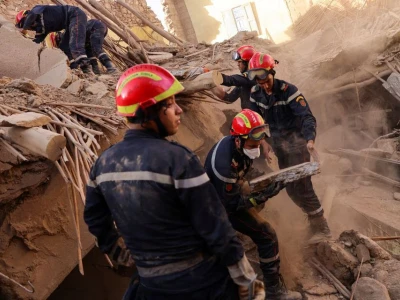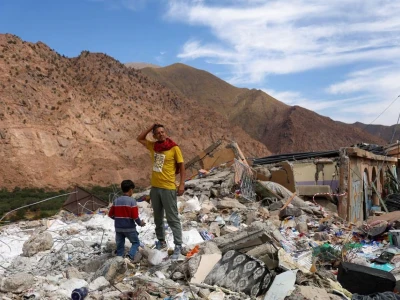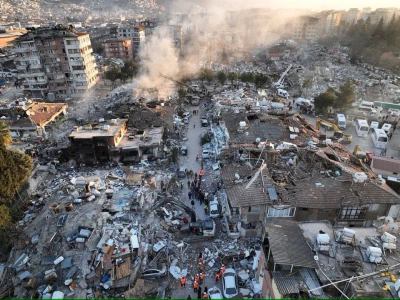
Morocco earthquake kills more than 1,300 people, survivors sleep outdoors
The quake was recorded at a depth of 18.5 km, typically more destructive than deeper quakes of the same magnitude.
AMIZMIZ, Morocco, Sept 9 (Reuters) - Moroccan earthquake survivors huddled for a night in the open on the High Atlas Mountains on Saturday, a day after the country's deadliest quake in more than six decades killed over 1,300 people and laid waste to villages.
Neighbours were still searching for survivors buried on the slopes, where houses of mud brick, stone and rough wood were cracked open and mosque minarets toppled by the quake that struck late on Friday. The historic old city of Marrakech also suffered extensive damage.
The Interior Ministry said 1,305 people had been killed and 1,832 injured by the quake, gauged by the U.S. Geological Survey at a magnitude of 6.8 with an epicentre some 72 km (45 miles) southwest of Marrakech.
In the village of Amizmiz near the epicentre, rescue workers picked through rubble with their bare hands. Fallen masonry blocked narrow streets. Outside a hospital, around 10 bodies lay covered in blankets as grieving relatives stood nearby.
"When I felt the earth shaking beneath my feet and the house leaning, I rushed to get my kids out. But my neighbours couldn’t," said Mohamed Azaw. "Unfortunately no one was found alive in that family. The father and son were found dead and they are still looking for the mother and the daughter."
Rescuers stood atop the pancaked floors of one building in Amizmiz, bits of carpet and furniture protruding from the rubble. A long queue formed outside the only open shop as people sought supplies. Underlining the challenges facing rescuers, fallen boulders blocked a road from Amizmiz to a nearby village.
Nearly all the houses in the area of Asni, some 40 km south of Marrakech, were damaged, and villagers were preparing to spend the night outside. Food was in short supply as roofs had collapsed on kitchens, said villager Mohamed Ouhammo.
Montasir Itri, a resident of Asni, said the search was on for survivors.
"Our neighbours are under the rubble and people are working hard to rescue them using available means in the village," he said.
The village of Tansghart in the Ansi area, on the side of a valley where the road from Marrakech rises up into the High Atlas, was the worst hit of any Reuters saw. Its once-pretty houses, clinging to a steep hillside, were cracked open by the shaking ground. Those still standing were missing chunks of wall or plaster. Two mosque minarets had fallen.
Abdellatif Ait Bella, a labourer, lay on the ground, barely able to move or speak, his head bandaged from wounds caused by falling debris.
"We have no house to take him to and have had no food since yesterday," said his wife Saida Bodchich, fearing for the future of their family of six with their sole breadwinner so badly hurt. "We can rely on nobody but God."
The village is already mourning ten deaths including two teenage girls, an inhabitant said.
Tremors were felt as far away as Huelva and Jaen in southern Spain. The World Health Organization said more than 300,000 people were affected in Marrakech and surrounding areas.
RUNNING FOR SHELTER
Street camera footage in Marrakech showed the moment the earth began to shake, as men suddenly looked around and jumped up, and others ran for shelter into an alleyway and then fled as dust and debris tumbled around them.
In the heart of the old city, a UNESCO World Heritage site, a mosque minaret had fallen in Jemaa al-Fna Square. Some houses in the tightly packed old city collapsed and people used their hands to remove debris while they waited for heavy equipment, said resident Id Waaziz Hassan.
Morocco declared three days of national mourning, during which the national flag will be flown at half staff throughout the country, the royal court said on Saturday.
The Moroccan armed forces will deploy rescue teams to provide affected areas with clean drinking water, food supplies, tents and blankets, it added.
Turkey, where powerful earthquakes in February killed more than 50,000 people, was among nations expressing solidarity and offering to provide support.
Algeria, which broke off ties with Morocco in 2021 after escalating tensions between the countries focused on the Western Sahara conflict, said it would open airspace for humanitarian and medical flights.
The quake was recorded at a depth of 18.5 km, typically more destructive than deeper quakes of the same magnitude. It was Morocco's deadliest earthquake since 1960 when a quake was estimated to have killed at least 12,000 people, according to the U.S. Geological Survey.
Mohammad Kashani, Associate Professor of Structural and Earthquake Engineering at the University of Southampton, compared scenes of the aftermath to images from Turkey in February: "The area is full of old and historical buildings, which are mainly masonry. The collapsed reinforced concrete structures that I saw ... were either old or substandard."
Marrakech is due to host the annual meetings of the International Monetary Fund and World Bank from Oct. 9.
An IMF spokesperson, asked about the planned meetings, said: “Our sole focus at this time is on the people of Morocco and the authorities who are dealing with this tragedy.”
Related
Related

Morocco survivors seek aid as earthquake toll passes 2,100

'This is betrayal': Moroccan in earthquake angry over gov't respo

Three women, two children pulled from rubble in Turkey

